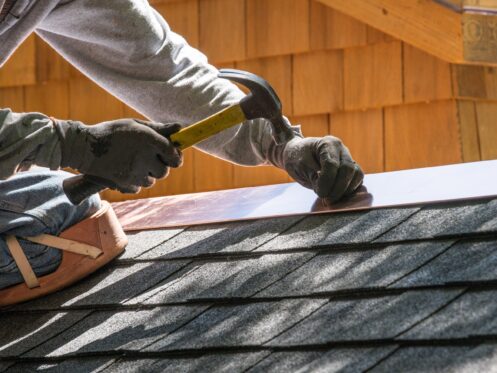Your roof is easily one of the most important parts of your home. It protects the interior from water damage and the environment, and it also blocks wild animals from getting inside. Because getting on top of your home can be difficult, you may not realize that you have a problem that will lead to a leaky roof in need of a roofing repair. Once a leak forms, it can cause mold and mildew to set in and even cause the ceiling to collapse. Find out the most common causes of a leaky roof.
Missing and Damaged Shingles
The most common reason your roof leaks is that you have missing and/or damaged shingles. Whether you have asphalt shingles or ceramic tiles, storms bring high winds that tear them off the roof. High winds and other weather conditions can also leave behind damage that keeps the shingles from doing their job. The Triad Area sees a few bad storms every year that damage and remove shingles and tiles. This exposes the underlayment on the roof. As more rain falls, it works its way through the underlayment and into your ceiling.
You can usually see signs of damaged or missing shingles without getting on your roof. Some of those signs include:
- Granules from the roof tiles that you find in your gutters
- Shingles that have curled edges
- Dark spots on the roof that indicate missing shingles
- Shingle pieces in your yard
Pipe Failure
Many homes in the Triad Area have one or more pipes running across their roofs. The pipe has flashing that protects it from damage. Also called a boot, the flashing might use a metal like copper or aluminum. Plastic and PVC pipes are also common. The flashing forms a seal around the pipe that protects it. When the flashing cracks or experiences any other type of damage, it leaves the underlayment exposed. Not only can water seep through and into the pipe, but it will also seep into your ceiling.
Roofing pipes often run to your bathroom or kitchen. Though you may not notice any problems when the flashing first breaks, you might hear the sound of running water. The water will slowly leech through the roof and into your ceiling. As it keeps growing, it can cause the entire ceiling to come down.
Lack of Valley Sealant
While flat roofs are common on commercial buildings, homes in the area have roofs with multiple peaks and valleys. A cross-gable roof, for example, features two sides with a third gable coming off one of the other sides. The spot where the two sides meet is a peak. When two sides meet at a lower angle and form an interior angle, you have a valley. A roof with one or more valleys must also have a layer of sealant to protect this spot from water damage.
Any rainwater that falls will pool in this valley. When you have enough sealant, the water will dry naturally within a few days. If you do not have enough sealant, the rainwater will pool in the valley and exert pressure on the roof. It can break down the shingles and form a leak. Roof sealant can wear down due to weather conditions, or the original roofer may not have used enough when they installed the roof.
Clogged Gutters
No matter what type of roof you have, your roofing system will feature gutters. While the gutters collect some of the debris that would otherwise land on your roof, it also gathers the rainwater that falls. There are also downspouts that transport the water and debris away from the roof and home to protect your foundation. You should hire someone to clean and inspect your gutters at least once a year. A professional will have the required tools and safety gear to work around the roof.
If you have clogged gutters, you risk a leaky roof forming. Gutters often pick up twigs and leaves along with other types of debris. Squirrels and some of the other small animals who live in the Triad Area also build nests in gutters. You may have clogged gutters because of those nests or due to a buildup of trash and debris. The clogs prevent water from freely leaving the gutters and reaching the downspouts. As the water flows over the gutters, it can damage the shingles and cause leaks on the top or sides of your roof.
Attic Condensation
Though the more common causes of a leaky roof come from problems outside of your home, some relate to your home’s interior like attic condensation. This can happen in both full-size finished attics and smaller unfinished attics that you use for storage. It commonly occurs in homes that have an HVAC system, too. When you use your furnace in the winter, the heat rises to the attic. Once it encounters the cooler temperatures in the area, it forms water droplets that become condensation. If you run your AC in the spring and summer, condensation can form as the hot and cold temperatures in your home come together.
Condensation is one of the leading causes of roof leaks because it builds up on wood surfaces. You will likely see some moisture on the walls and ceiling as well as the floor. The water droplets essentially eat through your home’s ceiling and cause water damage that requires expensive repairs.
Ice Dams
The Triad Area gets an average of eight inches of snow every year. Ice dams are a normal part of the freeze-thaw cycle. When the snow falls, it builds up on the roof. When the temperature rises, the ice melts causing water to pool. It then refreezes on the edge of the roof in the form of icicles. These icicles are often heavy enough that they break your shingles. They can also bring down a portion of the entire roof.
Ice dams can also cause roof leaks because they damage your gutters. The ice melts when the temperature rises and then freezes in the gutters, leaving behind large clogs. Those clogs allow any additional snowfall to pool on the roof and create a leak. In more extreme cases, the weight of the ice dam will cause the gutter to completely fall off your home. This leaves the roofline and the roof itself exposed to the elements.
Get Professional Roofing Help
Roof repairs in Greensboro are best left to the professionals. They have harnesses and other safety gear that helps them move around the roof without damaging it or injuring themselves. Roofing pros can also diagnose the exact cause of your roof leak and find out the best way to fix it. Call Aurora Pro Services Heating, Air, Plumbing, Electrical, & Roofing when you have a roof leak caused by any of these common reasons or any others. We also offer a complete list of plumbing services, including repairs, sump pumps, and water filtration systems. Additionally, our technicians perform HVAC installation, maintenance, and repairs. Electrical services are also available. Contact Aurora Pro Services Heating, Air, Plumbing, Electrical, & Roofing today to find out more about our extensive list of services.






